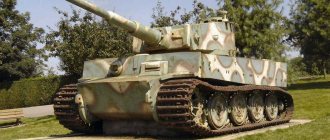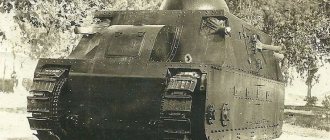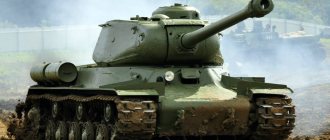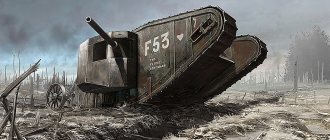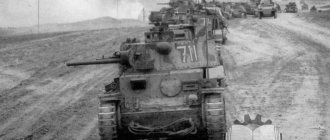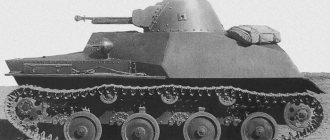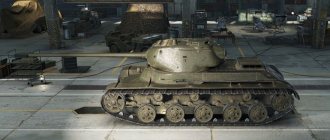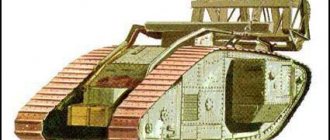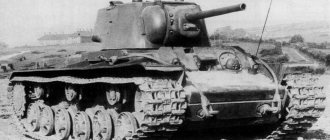Japanese amphibious tanks Type 2 "Ka-Mi"
The Pacific theater of operations is abundant in water resources. During World War II, armored vehicles with amphibious capabilities could have decisive tactical advantages on it.
Amphibious tank Type 2 "Ka-Mi"
For this reason, already in the 30s of the 20th century, Japan experimented with amphibious tanks. In 1941, the Imperial Navy commissioned Mitsubishi to modify an existing light tank into a specially designed amphibious vehicle.
To fulfill the order, engineers used the chassis of the Type 95 Ha-Go tank and equipped it with a fully welded hull. Rubber seals were installed in critical areas to ensure water tightness.
The original model was the Type 95 Ha-Go tank.
The weight of the vehicle reached 12.5 tons. On land, the tank accelerated to 35 km/h. The speed of the floating tank on the water reached 10 km/h. The tank turned out to be spacious and could accommodate 5 crew members.
The vehicle's buoyancy was provided by pontoons attached to the front and rear. The front pontoon had bulkheads and six compartments to increase reliability under enemy fire. A removable turret above the main hatch prevented water from entering the fighting compartment, and a large metal structure above the air intake prevented flooding in the engine compartment.
Floating tank Type 2 "Ka-Mi" with pontoons. Back view.
In the water, the tank engine drove two propellers. While afloat, the crew controlled the rudder via a cable system. For the level of that time, the car had decent seaworthiness in open water. After the tank came ashore, the crew disconnected the pontoons, and the vehicle continued the battle without these buoyancy elements.
The turret's armament consisted of a 37 mm cannon and a coaxial 7.7 mm machine gun. Another machine gun of the same caliber was installed in the front plate of the hull.
The first mass use of Ka-Mi amphibious tanks by the Japanese occurred on June 15-16, 1944 during the landing operation on the island of Saipan (Mariana Islands). However, American Bazooka grenade launchers and 37 mm anti-tank guns, as well as the lack of air and fire support, doomed the landing force to defeat.
Japanese amphibious tank type 2 Ka Mi
After this battle, Ka-Mi tanks also took part in the defense of the Philippines at the end of 1944. The raids carried out on them in the rear of American troops were also not particularly successful. Initially developed for offensive landing operations, the Ka-Mi amphibious tank, like other Japanese armored vehicles, played an exclusively defensive role.
Japanese tanks from the Second World War. Part II
"Chi-He"
Regarding Japanese tanks from the Second World War, there is a widespread opinion that they were completely behind their foreign competitors. It is true, but only partly. The fact is that the Japanese military and engineers, seeing the enemy’s armored vehicles, including potential ones, still made attempts to make a tank with the appropriate characteristics. Simultaneously with the Shinhoto Chi-Ha medium tank, a new armored vehicle was being developed, the design of which took into account all the shortcomings of the original Chi-Ha and its predecessors. The Type 1 or Chi-He project finally began to resemble European tanks of the time, both in design and combat performance.
First of all, it is necessary to note the updated design of the armored hull. For the first time in Japanese tank building, most of the parts were welded; rivets were used only in some places of the structure. In addition, in comparison with the Chi-Ha, the new Type 1 received more serious armor. The frontal rolled armor plates of the tank were 50 millimeters thick, the sides were twice as thin. The turret's forehead was made of a 25 mm plate and was partially covered by a 40 mm thick gun mantlet. Of course, in comparison with foreign tanks, the level of protection of the Chi-He did not look like something unique, but for the Japanese military industry it was a significant step forward. When designing the Type 1, the designers were faced with the task of increasing protection and firepower while maintaining the weight of the vehicle. For this reason, the frame of the tank was simplified as much as possible, and in some places the structure was completely removed; the contours of the hull and a number of internal mechanisms also underwent changes. As a result of all the changes, the new medium tank gained only a couple of tons in weight relative to the Chi-Ha. The combat weight of the Chi-He was 17.5 tons. The increased weight required the installation of a new engine; it became the “Type 100” produced. The 240-horsepower engine provided the tank with a specific power of about 13-14 horsepower per ton of weight. This was enough for a maximum highway speed of 45 km/h. Other driving characteristics remained at the level of previous tanks.
Another step towards bringing the tank to the form generally accepted in the rest of the world was the installation of a radio station on all vehicles and the introduction of a fifth person into the crew. Maintaining radio communications was the responsibility of the tank commander, who was relieved of his duties as a gunner. Aiming the gun now became the task of an individual crew member. The workplaces of the commander, gunner and loader were located in the fighting compartment, which required increasing the volume of the turret. However, the armament remained almost identical to the previous Shinhoto Chi-Ha tank. The main caliber of the Chi-He is the 47-mm Type 1 cannon. Despite the name, this weapon was not the same one that was installed on the Shinhoto Chi-Ha. Before installation on the Type 1 tank, the gun underwent major modernization. First of all, the recoil devices have undergone significant changes. The suspension system, in turn, retained its main features, but was also improved. Changing the mounting trunnions in practice led to a decrease in the width of the horizontal sector in which the gun could move. On the Chi-He, the gun barrel deviated from the longitudinal axis only 7.5° to the sides. The ammunition load of the Type 1 tank was similar to the supply of Shinhoto Chi-Ha shells - 120 unitary rounds of two types. The additional armament of the Chi-He consisted of two 7.7-mm machine guns, located according to the traditional layout for Japanese tanks. One was mounted on axles in the loophole of the frontal plate, the other - in the rear of the turret.
Major design work on the Type 1 theme was completed before the attack on Pearl Harbor. However, then the matter ended with the construction and testing of the prototype. Serial production of the Chi-He began only in mid-1943. Naturally, by this time Japan could no longer afford the construction of particularly large batches of new armored vehicles. As a result, no more than 170-180 Type 1 tanks were assembled, and about a year after its start, serial construction ceased. During its service with the troops, the new tank received mixed reviews. On the one hand, good armor on the front of the hull, under certain conditions, protected the tank even from American 75 mm guns. On the other hand, the 47-mm cannon still could not compete with the weapons of enemy tanks and artillery. Therefore, “Type 1” was unable to have any tangible impact on the course of the battles. Perhaps something would have changed if this tank had been built in larger numbers, but there is reason to doubt this too.
"Chi-Nu"
Understanding the not very bright prospects of the Type 1, the Japanese command instructed tank builders to make another medium tank capable of properly fighting enemy armored vehicles. The “Type 3” or “Chi-Nu” project implied the replacement of weapons with the “Type 1”. The 75mm Type 90 field gun was chosen as the new main weapon. It was developed in the early thirties based on the French Schneider gun. In turn, on the basis of the Type 90, a new gun was designed, designed specifically for installation on the Chi-Nu tank. This modification of the gun was called “Type 3”.
Due to the need to replace only the gun, the design of the Type 3 tank was taken practically unchanged from the Type 1. All improvements concerned improving the manufacturability of the assembly and ensuring the installation of a new, larger tower. The latter was a welded unit with a hexagonal shape in plan. The tower was welded from rolled sheets with a thickness of 50 mm (front) to 12 (roof). In addition, additional protection for the frontal projection was provided by a 50-mm gun mantlet. The “consequences” of installing a new large tower are interesting. Its front part covered most of the driver's hatch. For this reason, the entire Chi-Nu crew had to enter and exit the tank through two hatches in the turret roof and one in its left side. In addition, for servicing the gun and loading ammunition, there was another fairly large hatch at the rear of the turret. All changes led to an increase in the tank's combat weight. “Chi-Nu” weighed 18.8 tons when ready for combat. At the same time, driving performance has decreased slightly. The 240-horsepower diesel Type 100 could provide a maximum speed of only about 40 kilometers per hour, which was less than the corresponding figure for the Chi-He tank.
When converting the Type 90 gun into the Type 3 state, no significant design changes occurred. The gun was still equipped with a hydraulic recoil brake and a spring knurl. At the same time, the authors of the project had to resort to a little trick. Since they were required to quickly modify the gun, they did not change its layout. The recoil devices remained in place, in front under the barrel. Because of this, a special armored tray had to be installed on the front of the turret to protect the recoil brake cylinders. The gun's considerable weight and considerable dimensions forced us to abandon the idea of additional fine aiming without rotating the turret. On the Type 3, the gun could only swing vertically from -10° to +15° from the horizontal axis. The new tank's ammunition mounts contained 55 shells of two types, high-explosive fragmentation and armor-piercing. The latter, having an initial speed of 680 m/s at a distance of a kilometer, penetrated 65-70 millimeters of armor. The Chi-Nu's secondary armament consisted of only one machine gun in the front of the hull.
Maintenance of the Chi-Nu in the Hakata workshop, October 14, 1945
There is no exact data regarding the production of Type 3 medium tanks. According to one source, they began to be collected in mid-1943. Other literature indicates the fall of 1944 as the start of construction. The same strange situation is observed in estimates of the number of assembled cars. According to various sources, from 60 to 170 units were manufactured. The reason for such large discrepancies is the lack of necessary documents, which were lost in the last stages of the war. In addition, there is no information about the combat use of Type 3 tanks. According to available information, all the tanks built went to the 4th Panzer Division, which until the end of the war did not take part in hostilities outside the Japanese islands. The use of the Chi-Nu in the battles for Okinawa is sometimes mentioned, but in known American documents there is no information about the appearance of new equipment by the enemy. Probably all “Type 3” remained at the bases without having time to fight. After the end of World War II, a number of Chi-Nu tanks were used by the Japanese Self-Defense Forces.
"Chi-Nu", as well as several "Ho-Ni III" in the background, from the 4th Panzer Division
"Ka-Mi"
In the history of Japanese tank building there were several interesting projects that, for a number of reasons, were not particularly widely implemented. An example is the “Chi-Nu” described above. Another “small-scale” project appeared in connection with the peculiarities of the war in the Pacific Ocean. In preparing for the attack to the south, the Japanese command was faced with the issue of amphibious landings on the islands and the continental coast. Infantry support by tanks was carried out exclusively with the help of tank landing boats and ships. In particular, and therefore, most Japanese armored vehicles had a combat weight of less than 20 tons. For obvious reasons, military leaders wanted to get rid of the need to attract additional forces. Work towards creating an amphibious tank began in the late twenties, but then everything was limited to theory and a few experiments. Only in 1940 did full-fledged design work begin. The Type 2 or Ka-Mi tank was to become the main means of fire support for troops landing on the coast. The technical specifications implied the following use of an amphibious tank: a landing ship delivers armored vehicles to a certain distance from land, after which they reach the shore under their own power. It seems like nothing special. However, the designers were required to ensure both good seaworthiness of the tank and sufficient combat qualities. This was allowed to be done in any suitable way.
"Ka-Mi" is afloat. The similarity of the tank to a small ship speaks volumes about its seaworthiness.
The light tank Type 95 (Ha-Go) was taken as the basis for the Ka-Mi. The chassis of the old tank was modified for use in water. Housings with springs of the T. Hara system were hidden inside the housing. The building itself has undergone major changes. Unlike the Type 95, the Type 2 was assembled almost entirely by welding. Rivets were used only in those parts of the structure where a hermetic connection of parts was not required. The body was welded from rolled sheets up to 14 millimeters thick. A characteristic feature of the new tank was the shape of the hull. Unlike its land-based counterparts, the sea-based Ka-Mi did not have a large number of mating surfaces. In fact, the body was a simple box with several bevels. The arrangement of the engine and transmission was traditional for Japanese tanks of the second half of the thirties. The 120-horsepower diesel engine was placed in the stern, the transmission in the bow. In addition, two propellers were installed at the rear of the tank. At the same time, to save weight and ease of engine maintenance, there was no partition between the engine and fighting compartments. In terms of repairs, it was quite convenient. But in a combat situation, the roar of the engine greatly disturbed the crew. For this reason, it was necessary to equip the Ka-Mi with a tank intercom. Without it, the test tank crews could not hear each other. A new turret was mounted on the relatively wide top plate of the hull. It had a conical shape and accommodated the workplaces of two crew members: the commander and the gunner. The loader, mechanic and driver, in turn, were located inside the body.
The main armament of the floating Ka-Mi was 37-mm cannons. In the first series these were “Type 94”, installed on the “Ha-Go”, but then they were replaced by “Type 1”, which had a longer barrel. The gun's ammunition load was 132 rounds. Guidance in the horizontal plane was carried out both by rotating the turret and by shifting the gun itself within five degrees from the axis. Vertical aiming – from -20° to +25°. Additional weapons of the “Type 2” were two 7.7 mm machine guns. One of them was paired with a cannon, and the second was located in the front of the hull. Before the start of several landing operations, some Ka-Mis were equipped with additional equipment for the use of torpedoes. Two such ammunition were attached to the sides of the tank on special brackets and dropped using an electrical system.
Type 2 "Ka-mi" (101st Special Marine Amphibious Unit), with pontoons removed, aboard a transport transporting reinforcements to Saipan
The original Ha-Go underwent many changes, the purpose of which was to ensure proper seaworthiness. In particular, the shape of the upper part of the hull was determined by the peculiarities of the chosen method of ensuring buoyancy. Since the tank itself could not float normally on its own, they proposed installing special pontoons on it. A structure with a volume of 6.2 cubic meters was attached in the front part, and a volume of 2.9 in the rear. At the same time, the front pontoon was shaped like the bow of a watercraft, and the rear one was equipped with a boat-type plate rudder and its control system. To ensure survivability, the front pontoon was divided into six sealed sections, the rear - into five. In addition to the pontoons, a snorkel turret was installed above the engine compartment before moving through the water. Beginning in 1943, the kit for swimming began to include a lightweight metal structure designed for installation on a tank turret. With its help, the commander of a combat vehicle could monitor the situation not only through observation devices. Upon reaching the shore, the tankers had to discard pontoons and turrets. The reset procedure was carried out using a screw mechanism located inside the machine. In the first series, the Ka-Mi tanks were equipped with only two pontoons. Later, based on the results of combat use, the front one was divided into two independent parts. Thanks to this, the tank, having dropped its air tanks, could continue moving forward. The front pontoons were moved apart by the tank. Previously, they had to go around them.
The combat weight of the Type 2 tank was nine and a half tons. Suspended pontoons added another three thousand kilograms. With such a weight, the tank had a maximum speed on land of 37 kilometers per hour, and on water it accelerated to ten. The supply of diesel fuel was enough for a 170-kilometer march or a hundred-kilometer voyage. The amphibious tank could be used for an over-the-horizon landing and, in fact, the only limitation on landing the Ka-Mi was the situation at sea, waves, etc.
Japanese Type 2 Ka-Mi amphibious tanks captured on Shumshu Island. Two battalions of Japanese marines (rikusentai), which had 16 tanks of this type, were based on the islands of Paramushir and Shumshu
Serial production of the Ka-Mi began at the end of 1941. The pace of construction was relatively slow, which made it impossible to quickly re-equip the relevant Marine units. Nevertheless, the Type 2 tanks, even in quantities of several dozen, managed to receive good reviews. Which, however, were overshadowed by not very powerful weapons. Over time, the number of tanks in the army increased, but the pace of construction still remained unacceptable. As it turned out, one of the consequences of the original design of the tank was the high labor intensity of production. Therefore, the first landing operation with the massive use of Ka-Mi took place only in June 1944, it was a landing on the island of Saipan (Mariana Islands). Despite the surprise of the attack and the darkness of the night, the Americans quickly dealt with the advancing enemy. The combat use of Type 2 continued until the very end of the war. In recent months, due to the lack of landing operations, these tanks have been used as conventional ground armored vehicles and stationary firing points. Of the 180 amphibious tanks built, only eight have survived to this day. One of them is in the tank museum of the city of Kubinka, the rest are in the countries of Oceania.
Self-propelled guns based on the Chi-Ha tank
Until a certain time, there was no place for self-propelled artillery in the strategic fabrications of the Japanese command. For a number of reasons, infantry support was entrusted to light and medium tanks, as well as field artillery. However, since 1941, the Japanese military has initiated the creation of self-propelled gun mounts several times. These projects did not have a great future, but are still worth considering.
"Type 1" ("Ho-Ni I")
The first was the Type 1 (“Ho-Ni I”) installation, designed to combat enemy combat vehicles and fortifications. On the chassis of the Chi-Ha medium tank, in place of the turret, an armored conning tower with a frontal plate 50 millimeters thick was installed. This cabin design was used on all subsequent Japanese self-propelled guns of that time. Only the guns and their installation systems changed. A Type 90 field gun of 75 mm caliber was installed in the wheelhouse of the 14-ton combat vehicle. Rough aiming of the gun horizontally was carried out by turning the entire vehicle. Thin - with a rotating mechanism, within a sector 40° wide. Angles of descent/elevation – from -6° to +25°. The power of such weapons was sufficient to destroy all American tanks at distances of 500 meters. At the same time, the attacking Japanese self-propelled guns were themselves at risk of retaliatory fire. Since 1942, 26 Type 1 self-propelled guns have been built. Despite their small numbers, these artillery mounts were actively used in most operations. Several units survived until the end of the war, when they became American trophies. One copy of Ho-Ni I is in the Aberdeen Museum.
Self-propelled gun "Ho-ni II"
The next serial Japanese-made self-propelled gun was the Ho-Ni II, also known as Type 2. A 105-mm howitzer “Type 99” was installed on a chassis with a wheelhouse, completely taken from the “Type 1”. This self-propelled gun was primarily intended for firing from closed positions. However, sometimes, due to the situation, it was necessary to shoot at direct fire. The power of the gun was enough to destroy any American tanks at a distance of about a kilometer. Fortunately for the Americans, only 54 such gun mounts were built in 1943-45. Eight more were converted from serial Chi-Ha tanks. Due to the small number of self-propelled guns, the Ho-Ni II could not have a significant impact on the course of the war.
Self-propelled gun "Ho-Ni III"
A further development of "Type 1" became "Type 3" or "Ho-Ni III". The main weapon of this self-propelled gun was the Type 3 tank gun, developed for the Chi-Nu. The cannon's ammunition load of 54 rounds theoretically allowed the Ho-Ni III self-propelled gun to become a serious combat weapon. However, all three dozen self-propelled guns built were transferred to the 4th Tank Division. Due to the specific goals of this unit - it was intended for the defense of the Japanese archipelago - all Ho-Ni IIIs waited until the end of the war almost without losses, and then became part of the Self-Defense Forces.
Artillery support tank for amphibious assault forces armed with a 120 mm short-barreled cannon. Produced in a small series based on the "Chi-ha"
In addition to the Ho-Ni family, there was another self-propelled artillery unit based on the Chi-Ha tank. It was a Ho-Ro/Type 4 self-propelled gun. It differed from other Japanese self-propelled guns in the design of its armored cabin, as well as in its armament. “Ho-Ro” was the most powerful self-propelled gun of the Japanese Empire: the 150-mm howitzer “Type 38” could ensure the destruction of almost any target. True, Type 4 self-propelled guns also did not become widespread. The entire series was limited to only 25 cars. Several of the first production Ho-Ros managed to take part in the Battle of the Philippines. However, later all available self-propelled howitzers were transferred to the 4th Panzer Division. As part of this unit, the Type 4 self-propelled guns managed to fight only in Okinawa, where several units were destroyed by attacks by American troops.
Based on materials from the sites: https://pro-tank.ru/ https://wwiivehicles.com/ https://www3.plala.or.jp/ https://armor.kiev.ua/ https://aviarmor. net/ https://onwar.com/ Author: Ryabov Kirill
Amphibious tanks of other countries
American tank M4A2 DUPLEX DRIWE (DD) SHERMAN
American amphibious tank M4A2 (DD) SHERMAN
Weight: 34 tons. Speed afloat: 6 km/h. Crew: 5 people Introduction: 1944 Allies used DD tanks primarily during the Normandy invasion
Soviet amphibious reconnaissance tank T-38
Soviet amphibious reconnaissance tank T-38
Weight: 3.3 tons. Speed afloat: 5 km/h Crew: 2 people. Introduction: 1937 The Soviets used the T-38 very rarely in direct combat after the winter of 1940.
History and development[edit]
Experimental amphibious tank SR I-Go Ka-Mi Type 2 with attached buoyancy compartments Ka-Mi Tanks Type 2 on Saipan
Back in 1928, the Japanese army was developing amphibious tanks and created several experimental models, such as the Sumida Amphibious Armmored Car (AMP) , SR I-Go, SR II Ro-Go, SR III Ha-Go, which were produced only as one-off prototypes for concept testing in the 1930s. Each SR series was amphibious tanks weighing from 3.6 to 7 tons with a crew of 2 to 3 people, armed with machine guns. [12]
In 1940, the Imperial Japanese Navy began developing amphibians. Mitisubishi used the knowledge gained from the SR program and the Type 95 Ha-Go light tank as a base. Type 1 Mi-Sha a/k/a/ "Type 1 Ka-Mi Floating Tank" was the first IJN prototype produced. [3] Type 1 led to the development of the Ka-Mi Type 2, which was produced in 1942. The Ka-Mi Type 2 was developed for the IJN Special Amphibious Force for amphibious invasion of the Pacific Islands without proper port facilities and for various special operations. [4] Type 2 Ka-Mi tanks were organized into "several amphibious tank units". [5]Starting from 1942, between 182 and 184 units of this tank were built. [6] [7]
Combat report [edit]
Ka-Mi Type 2 tanks without a flotation machine after being captured by Australian soldiers
The Ka-Mi Type 2 entered service after the early campaigns of World War II, and was therefore for the most part too late to be used in its original amphibious mission. Many units were assigned to naval garrison detachments in the South Seas and the Netherlands East Indies.
The Ka-Mi Type 2 was first used in combat on Guadalcanal in late 1942. They were later met by the United States Marine Corps in the Marshall and Mariana Islands, especially Saipan, where they supported the Yokosuka-based Special Naval Landing Force (SNLF) in an unsuccessful amphibious operation. [13] They were also used during the fighting on the Philippine island of Leyte in late 1944, when they supported the 101st Strategic Nuclear Forces in Ormoc Bay. [14] According to Ralph Zambro in his book Tank Aces, several Ka-Mis were destroyed by a US Army LVT-1 off the coast of Leyte during a battle against the only amphibious tank in history; However, this is doubtful, since most of the Ka-Mi tanks were destroyed after they went ashore. [15] A few more were captured by US Army troops on Luzon in 1945, and several others were captured by Australian and Commonwealth forces. [10]
World Of Man Dreams
Official designation: Type 2 “Ka-mi” Alternative designation: Mizu Sensha 2602 Start of design: 1941 Date of construction of the first prototype: 1942 Stage of completion: serially produced in 1942-1945, used in the Pacific theater until the summer of 1945 of the year.
The tank was developed in 1940 on instructions from the command of the Japanese fleet. It was intended for use in amphibious operations in the Pacific Ocean. The light tank “Ha-Go”, type 95, was taken as the basis. To ensure buoyancy, the hull was given a pontoon-like shape and its width was increased. Devices for attaching front and rear additional pontoons are mounted on the hull at the front and rear.
To move through the water, two propellers and a rudder were mounted at the rear of the vehicle. The propellers were driven by an engine. The weapons were housed in a new large tower. In addition to the 37 mm cannon, a 6.5 mm machine gun coaxial with the cannon was also installed here. A tank telescopic sight was used to control the fire from the cannon. The gun was aimed at the target vertically by hand, and horizontally by a mechanical drive. Another 6.5 mm machine gun was installed in a ball joint on the left side of the front hull plate. Fire from it could be carried out after the separation of the front pontoon after landing on the shore. To ensure air supply to the engine, a removable air intake device was installed at the rear of the turret. Communication with the tank was carried out using a radio station. The tank was mass-produced from 1942 to 1943. and was used in battles of World War II.
In 1941, the Ka-Mi amphibious tank, based on the Ha-Go light tank, was adopted to support special operations. The welded sealed body of the tank increased slightly and became box-shaped with a developed lip plate. The engine exhaust pipe was placed on the roof of the engine compartment.
The transmission included a gearbox with an additional reduction gear, which provided 8 forward and 2 reverse speeds, and also carried out power take-off to the propellers. The chassis of the suspension spring was changed and the steering wheel was removed inside the body and lowered to the ground. Four support rollers on board were interlocked in pairs on balancers; three support rollers prevented sagging of the fine-link caterpillar chain, 305 mm wide; the drive wheel with a lantern gear was located in front.
Widening the turret plate made it possible to increase the turret ring; an elongated 37-mm cannon and a 7.7-mm machine gun were installed in a conical turret made of the “Ke-Ni” type. For boarding and disembarking the crew, there was a tower hatch with a double-leaf lid in the aft part and an outlet from the engine.
Since 1943, an improved version was produced - Type 2 "Ka-Mi". Behind the propellers, rudders were installed, connected by steel cables to a steering wheel in the turret, so that the commander controlled the vehicle while afloat. A protective casing with viewing windows was attached to the roof of the tower. The tanks were equipped with a radio station and intercom (TPU). A total of 180 floating Ka-Mis were produced before the end of the war, which were used in a number of operations, in particular in the Marshall Islands in February 1944, on Saipan in June and Leyte in October 1944.
American soldiers near a damaged Japanese Type 2 Ka-Mi amphibious tank near the city of Ormoc in the Philippines.
The tower had a shield that protected the hatch from splashes, and a streamlined air intake duct protected from splashes by a lid was installed above the engine. To give the vehicle buoyancy at the front and rear, metal pontoons were attached to the clamps, giving the hull a streamlined “ship-like” shape. This ensured good seaworthiness and stability even with noticeable pitching. The front pontoon with a volume of 62 m3 consisted of two symmetrical halves, divided into three compartments each. The volume of the rear pontoon is 2.9 m3.
To get the vehicle ashore, a flat bottom was required, although some inclination of the lower branch of the caterpillar facilitated the exit. On the shore, the pontoons were easily dropped without the crew leaving the vehicle. The bow pontoon disintegrated after being dropped and did not block the path. While afloat, the cracks and shoulder straps of the tower were sealed with rubber gaskets. The propeller on the water was two propellers installed under the bottom.
Japanese Type 2 "Ka-mi" amphibious tanks (101st Special Marine Amphibious Unit), with pontoons removed, on board a transport that delivers reinforcements to the island of Saipan.
TACTICAL AND TECHNICAL CHARACTERISTICS OF THE FLOATING TANK Type 2 "Ka-Mi" model 1942
| COMBAT WEIGHT | 12500 kg (with pontoons) 9500 kg (without pontoons) |
| CREW, people | 5 |
| DIMENSIONS | |
| Length, mm | 4830 (without pontoons) 7429 (with pontoons) |
| Width, mm | 2790 |
| Height, mm | 2340 |
| Ground clearance, mm | 360 |
| WEAPONS | one 37 mm Type 1 cannon and two 6.5 mm Type 97 machine guns |
| AMMUNITION | 75 shots and 3300 rounds |
| AIMING DEVICES | telescopic gun and optical machine gun sight |
| RESERVATION | hull forehead (top) - 12 mm hull forehead (bottom) - 6 mm hull side - 14 mm bottom - 8 mm hull rear - 8 mm hull roof - 8 mm side, rear and turret roof - 12 mm gun mantlet - 14 mm |
| ENGINE | Mitsubishi NVD6120, 6-cylinder, diesel, air-cooled, 120 hp. at 1800 rpm |
| TRANSMISSION | mechanical type: gearbox, gearbox (4 + 1), propeller shaft connected by bevel gears to final clutch shafts, single-stage final drives |
| CHASSIS | (on one side) four double road wheels with a Hara-type suspension, two support rollers, a front drive wheel (lantern engagement); small-link caterpillar, single-ridge, 103 tracks, 305 mm wide and 84 mm pitch |
| SPEED | 37 km/h on the road 10 km/h afloat |
| HIGHWAY RANGE | 170 km by road ~100 km afloat |
| OBSTACLES TO OVERCOME | |
| Elevation angle, degrees. | ? |
| Wall height, m | 0,75 |
| Fording depth, m | floating |
| Ditch width, m | 2,00 |
| MEANS OF COMMUNICATION | radio station with whip antenna and intercom |
"Ka-Mi" - amphibious tank
Published by: dokaspez, 03/14/2018, 11:38, Equipment and weapons, 632, 0
The Ka-Mi
was a Japanese amphibious tank from World War II and the only mass-produced Japanese amphibious tank.
The name of the tank is formed from “ka” - “floating” and “mi” - from the name . "Ka-Mi" were produced in small series from 1942 until the end of the war, the total production was 184 vehicles. Such a small volume is largely due to the complexity of the design of the amphibious tank compared to other Japanese tanks, which required a large amount of manual labor during assembly. The Ka-Mis
released were put at the disposal of Marine Corps units to replace the small Type 94 tanks and light Ha-Go tanks.
Their huge range on water and seaworthiness, comparable to a small boat, made it possible to land them at a considerable distance from the shore. The trouble with the Ka-Mi
was that they appeared too late - the tank became available in any significant quantities only by 1943, when Japan was forced to switch to strategic defense, and the tank, created for offensive landing operations, had few capabilities prove yourself. In addition, the lack of artillery support, coupled with the loss of Japanese air superiority, significantly limited the capabilities of the landing force and did not allow the Ka-Mi's capabilities to be fully used.
Performance characteristics:
Show / Hide text
Combat weight - 12500 kg (with pontoons), 9500 kg (without pontoons) Crew, persons. — 5 Overall dimensions: Length, mm — 4830 (without pontoons), 7429 (with pontoons) Width, mm — 2790 Height, mm — 2340 Ground clearance, mm — 360 Armament: one 37-mm Type 1 gun and two 6.5- mm machine gun Type 97 Ammunition: 75 rounds and 3300 rounds. Aiming devices: telescopic gun sight and optical machine gun sight. Reservations: hull forehead (top) - 12 mm hull forehead (bottom) - 6 mm hull side - 14 mm bottom - 8 mm hull rear - 8 mm hull roof - 8 mm side, rear and turret roof - 12 mm gun mantlet - 14 mm Engine: Mitsubishi NVD6120, 6-cylinder, diesel, air-cooled, 120 hp. at 1800 rpm Transmission: mechanical type: gearbox, gearbox (4 + 1), driveshaft connected by bevel gears to final clutch shafts, single-stage final drives Chassis (on one side) four double road wheels with Hara type suspension, two supporting rollers, front drive wheel (pinion engagement); small-link caterpillar, single-ridge, 103 tracks with a width of 305 mm and a pitch of 84 mm Speed: 37 km/h on the road, 10 km/h afloat Cruising range on the highway: 170 km on the road. Obstacles to be overcome: Wall height, m - 0.75 Ford depth, m - floating Ditch width, m - 2.00 Communications: radio station with a whip antenna and internal intercom.
The first combat use of the Ka-Mi was the Battle of Guadalcanal at the end of 1942, in which several pre-production Ka-Mis took part.
Several Ka-Mis were later used in the Marshall Islands in the defense of the air base on Roy Atoll in early 1944. The first mass use of the Ka-Mi took place in 1944 in the Mariana Islands, in a night landing operation from June 15 to 16 on the island of Saipan. The landing force, which had neither aviation nor artillery support, was doomed to failure; the Ka-Mi landing on the enemy’s flank were quickly destroyed by anti-tank artillery and Bazooka and Sherman RPG fire. A small number of Ka-Mis were used by the 101st Special Amphibious Unit in the defense of the Philippines in late 1944, where they were used in unsuccessful raids behind American lines. At the end of the war, individual Ka-Mis, like other Japanese armored vehicles, were used as stationary firing points on Iwo Jima and Okinawa.
Several Ka-Mis have survived to this day 2) Victory Park, Moscow, exhibition of military equipment and engineering structures. 3) Shumshu Island of the Kuril ridge, one of those shot down during the battles on August 18, 1945 at altitude 171. Palau - 7 “Ka-Mi” located on different islands. All of them are abandoned in the open air and are in poor condition. The model of one of these Japanese Ka-Mi tanks, type "2", exhibited in the Central Museum of the Great Patriotic War, was recreated using genuine fragments of the Ka-Mi tank, discovered during a search expedition in 2010 to the Kuril Islands Shumshu and Paramushir.
- 0
Design[edit]
The Ka-Mi Type 2 was based on the Army's Type 95 Ha-Go light tank, but had an all-welded hull with rubber seals instead of riveted armor. It had to be waterproof. Large, hollow pontoons made of steel plates were attached to the front glacis plate and rear decks to give the necessary buoyancy. [8] The forward pontoon was internally divided into two "symmetrical sections", and each was divided into three separate watertight compartments to minimize the effects of damage from flooding and artillery fire. [9] The pontoons were attached by a "little clamp" system with a release inside the tank to deploy them after landing for ground combat. [10]
Its gun turret was a high velocity Type 1 37 mm cannon and a co-axial Type 97 light machine gun. The second Type 97 light machine gun was located in the bow of the tank. [7]
The tank was capable of speeds of up to 10 km/h on water with a flight range of 140 km due to two propellers located at the rear of the hull and driven by the tank's engine. [11] The steering was under the control of the tank commander, who controlled a pair of rudders from the turret via cables. The crew included an onboard mechanic. [12] It was "the best amphibious tank of the war." [10]
Links[edit]
- Foss, Christopher (2003). The Great Book of Tanks: The World's Most Important Tanks from World War I to the Present
. Zenit Press. ISBN 0-7603-1475-6. - Hara, Tomio (1973). Japanese combat vehicles, light tanks and wedges
. AFV Weapon Profile No. 54. Limited profile publications. - Rottman, Gordon L.; Takizawa, Akira (2008). Japanese tank tactics during World War II
. Osprey Publishing. ISBN 978-1846032349. - Tomczyk, Andrzej (2003). Japanese Armor Vol.
3 . AJ Press. ISBN 978-8372371287. - Zaloga, Stephen J. (2007). Japanese tanks 1939–45
. Osprey Publishing. ISBN 978-1-8460-3091-8. - Zambro, Ralph (1997), Tank Aces, Pocket Books/Simon & Schuster, ISBN 0-671-53612-5
Notes[edit]
- Jump up
↑ Hara 1973, p. 2. - Tomczyk 2003, pp. 3, 4.
- Tomczyk 2003, p. 4.
- Zaloga 2007, pp. 23, 27.
- Rottman & Takizawa 2008, p. 15.
- Zaloga 2007, p. 17.
- ^ ab Imperial Japanese Army Taki: Type 2 "Ka-Mi" landing vehicle
- Tomczyk 2003, p. 6.
- Tomczyk 2003, pp. 6, 7.
- ^ abc Pledge 2007, p. 23.
- Tomczyk 2003, pp. 7, 32.
- Tomczyk 2003, p. 22.
- Tomczyk 2003, pp. 29, 30.
- Tomczyk 2003, p. 30.
- Rottman & Takizawa 2008, pp. 14, 15.
Surviving cars[edit]
The Kubinka Tank Museum in Moscow, Russia has 2 types of Ka-Mi on display, complete with front and rear pontoons. The almost completed building is located near the airport in Babeldaob, Palau. Another example is located in Koror, Palau. The latter is notable for the fact that a heavy anti-aircraft machine gun is still mounted on the rear pontoon. These two tanks were once located in the center of Babeldaop Island in the late 1980s. In fact, they were buried by the Japanese, either to prevent them from falling into American hands after the surrender, or as defensive fortifications. After the war they were excavated by local residents. They were subsequently moved, one to the Old Communications Center south of the airport, and the other to Koror, as part of the war memorial displays.

